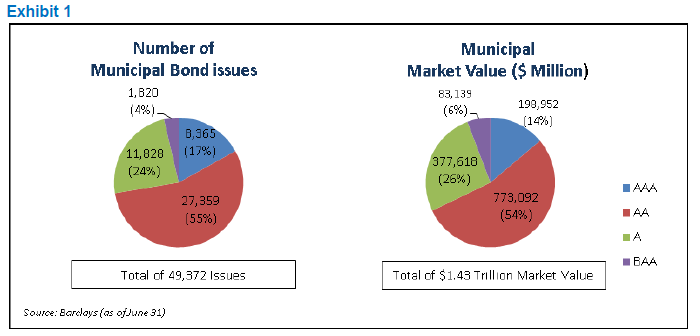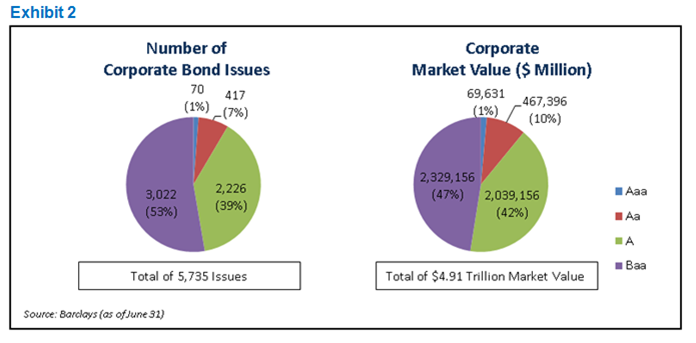
Director of Municipal Bonds
Municipals Experienced Strengthening Technicals during the Quarter.
The tax-exempt sector experienced mixed performance during the first quarter overall, but stronger technicals were building by the end of the quarter. At the beginning of the year, municipal bond investors were concerned about both a rising rate environment and the prospects for major tax reform that could reduce the relative valuations for the sector. Those concerns resulted in very robust demand for short-dated maturities around the 5 year and shorter area that helped push yields lower by 27 and 24 basis points (bps) in 3 and 5 years, respectively. By contrast, the worries over the potential for a substantial cut to the corporate tax rate to 20% have generally been felt in the 15 to 30 year area of the yield curve. Insurance companies and banks, the investors that provide most of the sponsorship to that part of the yield curve, have been very cautious and have favored a neutral positioning until more clarity exists on the extent of tax reform. Yields in that range ended the quarter 1 to 3bps higher. The clear shift in reducing duration risk during the quarter resulted in the slope of the yield curve from 2 to 30 years steepening by 37 bps to a one-year high of 220bps on March 9th.
Since that time, the market did receive some unexpected support from positive developments related to supply technicals. March is historically one of the weakest technical periods of the year. New issuance typically spikes during the month as state and local governments finalize budgets and identify spending initiatives, along with refinancing opportunities. This building supply cycle typically outstrips demand, as reinvestment flows from coupons/calls/maturities fall to the lowest point of the year during March and April. However, this year, March supply came in well-below expectations at $29.8B, which was a drop of 30% from March 2016 and 20% below the 10 year average for March. The major catalyst for the drop has been the rise in interest rates. Municipal 10 year rates moved to a 2017 high of 2.49% during March, which was 78bps higher than average 10yr yields during 2016. The higher rate environment substantially reduced the universe of deals that could generate the necessary reduction in debt servicing costs to execute refinancings.
The market also benefited from the failure of congress to pass repeal and replacement of the Affordable Care Act. The lack of repeal of the law left intact the 3.8% Medicare surtax on investment income, which continues to make tax-exempts attractive relative to taxable alternatives subject to this tax. Additionally, the repeal and replace legislation would have generated a substantial reduction in the budget deficit and would have helped pave the way for a more aggressive push toward cutting corporate rates to the 20% level targeted by the House Speaker, Paul Ryan. Without the budget deficit savings, the market appears to now expect a corporate rate in the 27% to 30% range. Since March 15th, these developments resulted in 10 year muni yields falling by 24bps and the slope of the yield curve from 2 to 30 years to flatten by 17bps.
In looking at our outlook for the 2nd quarter, technicals should continue to exhibit a strengthening trend into the end of the quarter. Reinvestment flows are expected to be the highest of the year during June and July 1st, while supply is expected to remain manageable. However, if rates continue to move lower, cost savings from refinancings could become more compelling and we could see a renewed surge in supply levels. The market is also continuing to wait for more clarity on the extent of tax reform and the sector could experience some volatility around this issue. With our more constructive view on demand technicals, we are transitioning accounts from an underweight to a neutral bias.
Disclaimer: Asset Allocation & Management Company, LLC (AAM) is an investment adviser registered with the Securities and Exchange Commission, specializing in fixed-income asset management services for insurance companies. Registration does not imply a certain level of skill or training. This information was developed using publicly available information, internally developed data and outside sources believed to be reliable. While all reasonable care has been taken to ensure that the facts stated and the opinions given are accurate, complete and reasonable, liability is expressly disclaimed by AAM and any affiliates (collectively known as “AAM”), and their representative officers and employees. This report has been prepared for informational purposes only and does not purport to represent a complete analysis of any security, company or industry discussed. Any opinions and/or recommendations expressed are subject to change without notice and should be considered only as part of a diversified portfolio. A complete list of investment recommendations made during the past year is available upon request. Past performance is not an indication of future returns. This information is distributed to recipients including AAM, any of which may have acted on the basis of the information, or may have an ownership interest in securities to which the information relates. It may also be distributed to clients of AAM, as well as to other recipients with whom no such client relationship exists. Providing this information does not, in and of itself, constitute a recommendation by AAM, nor does it imply that the purchase or sale of any security is suitable for the recipient. Investing in the bond market is subject to certain risks including market, interest-rate, issuer, credit, inflation, liquidity, valuation, volatility, prepayment and extension. No part of this material may be reproduced in any form, or referred to in any other publication, without express written permission.




